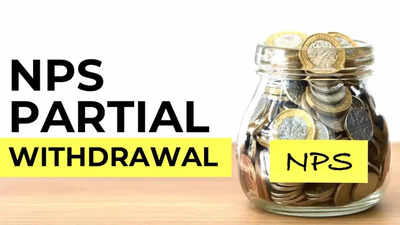- News
- Business News
- Financial Literacy News
- What are the NPS partial withdrawal rules? Know eligibility, limits and more details
Trending
What are the NPS partial withdrawal rules? Know eligibility, limits and more details
NPS enables partial fund withdrawals after three years for eligible subscribers. Withdraw up to 25% of own contributions, excluding employer funds and returns, for specific purposes like education, marriage, housing, medical needs, disability, skill development, and entrepreneurship.

NPS partial withdrawal: The National Pension System (NPS) allows subscribers to withdraw a portion of their funds under specific conditions. But you need to meet specific conditions to do so. Here's what you need to know about eligibility, withdrawal limits, permissible uses, and frequency of withdrawals.
Who is eligible for NPS partial withdrawal?
As per an ET report, you can only make a partial withdrawal from the NPS after three years.This means you must have been an NPS subscriber for at least three years from the date you joined or the date your Permanent Retirement Account Number (PRAN) was issued to be eligible to withdraw a portion of your funds.
How much can you withdraw?
ALSO READ | EPF withdrawal claim: How long does it take to process Employees’ Provident Fund account claim?
When can you withdraw?
According to the Pension Fund Regulatory and Development Authority (PFRDA), you can make a partial withdrawal from the National Pension System (NPS) for the following reasons:
1. Higher education of children: To cover the costs of college or university for your children.
2. Marriage of children: To pay for your child's wedding expenses.
3. Purchase/construction of a first house: For buying or building your first home.
4. Medical treatment: To cover specified illnesses for you, your spouse, or your children.
5. Disability or incapacitation: To manage medical and related expenses due to disability or incapacity suffered by you.
6. Skill development or re-skilling: For self-improvement or career advancement through skill development or training.
7. Establishing a venture or start-up: To set up your own business or start-up (only for subscribers in the 'All Citizens' sector).
How often can you withdraw?
You can make a maximum of three partial withdrawals from your NPS account during its entire tenure. This limit applies no matter how long you maintain the account. So, if you withdraw money from your NPS, remember that you can only do this up to three times throughout your membership.
Key points to remember
You need to wait five years between partial withdrawals from your NPS account. However, if you're withdrawing to cover medical expenses for a specified illness, you don't have to wait. According to the PFRDA, for any later withdrawals, you can only take out the extra money you added to your account since the last withdrawal.
Who is eligible for NPS partial withdrawal?
As per an ET report, you can only make a partial withdrawal from the NPS after three years.This means you must have been an NPS subscriber for at least three years from the date you joined or the date your Permanent Retirement Account Number (PRAN) was issued to be eligible to withdraw a portion of your funds.
How much can you withdraw?
An NPS subscriber can withdraw up to 25% of their own contributions. If you're part of a government or corporate NPS plan, you can't withdraw from the part of the fund contributed by your employer. Also, the returns earned on your contributions are not included in the 25% you can withdraw.
ALSO READ | EPF withdrawal claim: How long does it take to process Employees’ Provident Fund account claim?
When can you withdraw?
According to the Pension Fund Regulatory and Development Authority (PFRDA), you can make a partial withdrawal from the National Pension System (NPS) for the following reasons:
1. Higher education of children: To cover the costs of college or university for your children.
2. Marriage of children: To pay for your child's wedding expenses.
3. Purchase/construction of a first house: For buying or building your first home.
4. Medical treatment: To cover specified illnesses for you, your spouse, or your children.
5. Disability or incapacitation: To manage medical and related expenses due to disability or incapacity suffered by you.
6. Skill development or re-skilling: For self-improvement or career advancement through skill development or training.
7. Establishing a venture or start-up: To set up your own business or start-up (only for subscribers in the 'All Citizens' sector).
How often can you withdraw?
You can make a maximum of three partial withdrawals from your NPS account during its entire tenure. This limit applies no matter how long you maintain the account. So, if you withdraw money from your NPS, remember that you can only do this up to three times throughout your membership.
Key points to remember
You need to wait five years between partial withdrawals from your NPS account. However, if you're withdrawing to cover medical expenses for a specified illness, you don't have to wait. According to the PFRDA, for any later withdrawals, you can only take out the extra money you added to your account since the last withdrawal.
End of Article
FOLLOW US ON SOCIAL MEDIA

















